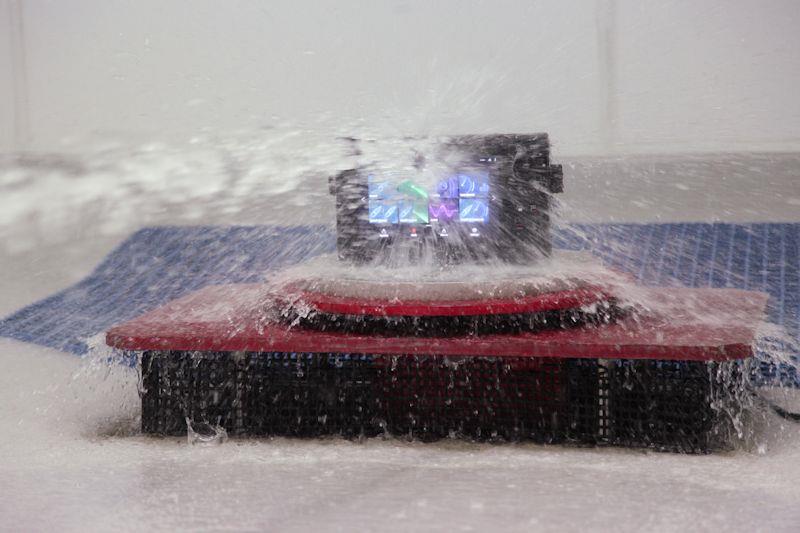
Raymarine - Extreme product testing for extreme conditions
by Raymarine 4 Apr 2023 16:00 UTC

Extreme product testing for extreme conditions © Raymarine
With new climate extremes, environmental testing in the harshest of conditions is critical to a products success
Changes in climate extremes and their impacts on the natural physical environment means that technology needs to be more durable than ever. The ability of a product to withstand the environment within which it has to operate, is critical to its success and the reason Raymarine goes beyond industry standards to test its marine products.
Raymarine's testing centre in the UK is at the forefront of the industry. The facility provides a comprehensive range of accredited marine environmental testing, from hard drops, prolonged vibration, extreme temperatures, wireless emissions, relentless rain and spray, full submersion, and the simulation of months at sea inside a salt mist chamber.
Vibration test
Vibration is the hidden enemy for both electronics and mechanical structures. Constant shaking across a range of frequencies can create loose connections, fatigue wires, damage solder joints and result in equipment failure.
Vibration testing at Raymarine's environmental test centre goes well beyond standard tests. In the shaker room, vertical and horizontal shakers perform swept sine and dwell tests, subjecting items to a vibration sine tone across a broad frequency range. Where a resonance is found during the sweep, testers dwell on that frequency for two hours, then check for fatigue damage. The standard test is 5Hz-100Hz, but Raymarine pushes that to 600Hz, as well as performing shock and random vibration tests simulating and surpassing real-life vibration data from customers' boats.
Electromagnetic compatibility
Following brutal vibration and drop testing, products are taken to the EMC (electromagnetic compatibility) area, where power supply tests are performed. Interference from switching on other boat equipment can disrupt the shared power supply, so these tests ensure that products will continue to work over the various voltage ranges they might experience. These tests cover issues such as voltage drops, inrush current and surges.
Products are then moved to Raymarine's radiated immunity chamber, where testing ensures that products can still operate efficiently when exposed to a powerful radiated electromagnetic field. The walls of the test chamber are covered in pyramid-shaped material designed to prevent reflections so that only the direct signal from the antenna is received, making it easier to produce a uniform test field. In this process, the transmit antenna is placed at the far end of the chamber while the test product is placed on a table in the pre-calibrated field and monitored to ensure it operates correctly under radiation, without failures such as lines of interference appearing on a video feed.
In a separate chamber, radiated emissions testing identifies the unintended release of electromagnetic energy. To prevent interference from external signals, the outer chamber is made from two layers of steel. Inside, a combination of ferrite tiles and blue absorber material stops reflections.
From the freezer to the oven to the helm
Mariners operating in polar waters can experience huge seas and sub-zero temperatures. Closer to the equator, searing temperatures create a new set of demands. In either extreme, functional electronics remain a matter of survival, which is why Raymarine gives all its products such a punishingly hard time at its environmental test centre. Extreme temperature testing takes place in specially designed thermal chambers, where products are repeatedly tested and soaked overnight to ensure they start up, restart and function over a massive temperature range between -25 degreesC (-13 degreesF) and 55 degreesC (131 degreesF), and also survive non-operational storage in temperatures between -30 degreesC (-22 degreesF) and 70 degreesC (158 degreesF).
During hot room testing, products are placed inside a 55 degreesC (131 degreesF) chamber for life tests, where they often remain for months. Along similar lines, an IR (Infrared Radiation) test simulates noon sunshine to ensure that displays don't black out and that no sunlight damage such as glow marks or buckled film occurs inside the display panels.
Thereafter, the salt mist room exposes products to continuous salt spray for two hours before they are then left for seven days in a warm, damp atmosphere. This process is repeated four times, taking the test duration to 28 days. Products are then examined to ensure that salt and water has not damaged the coatings causing blisters, cracks or colour loss.
Water Ingress Testing
The next testing is in the wet room, a water ingress area where IPX6 tests are carried out. Products carry this rating if they can withstand arduous tests designed to assess an item's water and/or dustproofing capabilities. One such test requires products to be continually sprayed with at least 100 litres of water per minute from a fire hose, for a minimum of 30 minutes, and for the unit to continue to function both during and after the test.
The industry standard requires products to be left in a damp and drizzly atmosphere for half an hour, but Raymarine leaves them in for an entire day to replicate real-world usage, with testers taking the products apart afterwards to make sure there's no water inside. A drip of water over the life of a product becomes a flood inside the unit and is unacceptable.
But these water ingress tests are merely the opening act. Subsequent IPX7 tests determine products' abilities to withstand immersion at a defined depth for a specified duration. The immersion tanks are also used to check sonar transducer performance. As thorough as the above test procedures are, Raymarine does even more. It employs AIS simulators to test AIS transceivers, DSC base station simulators for radios, GNSS simulators, Wi-Fi simulators and more.
Explore the new Raymarine website at www.raymarine.com